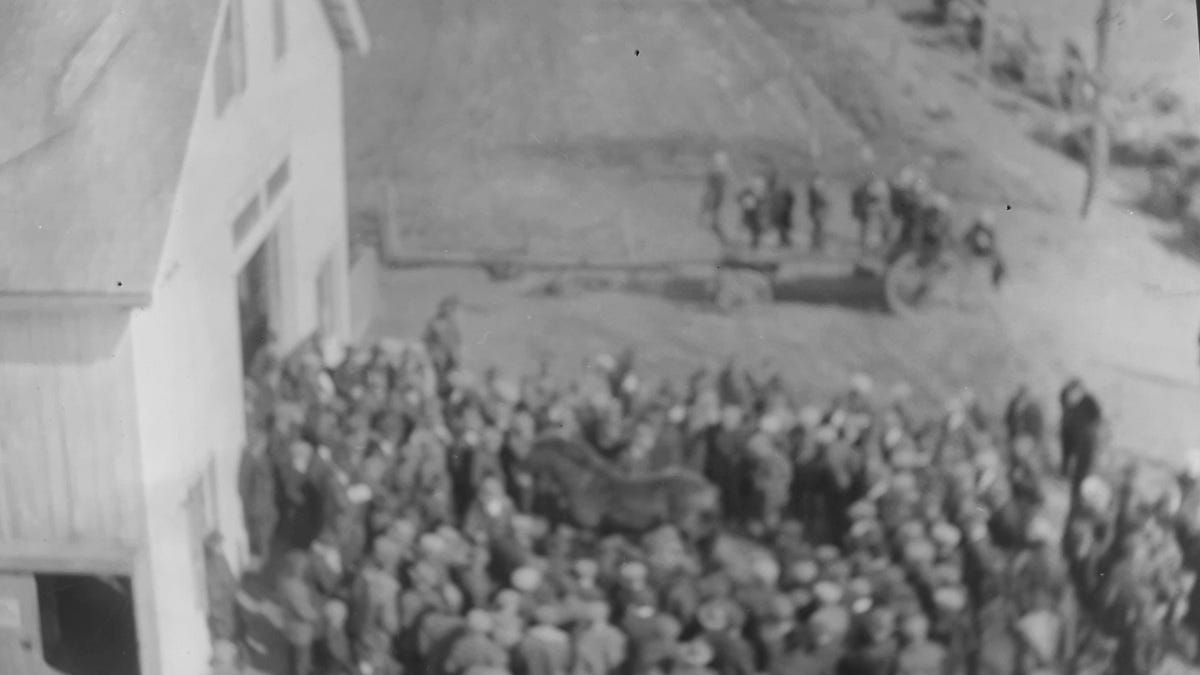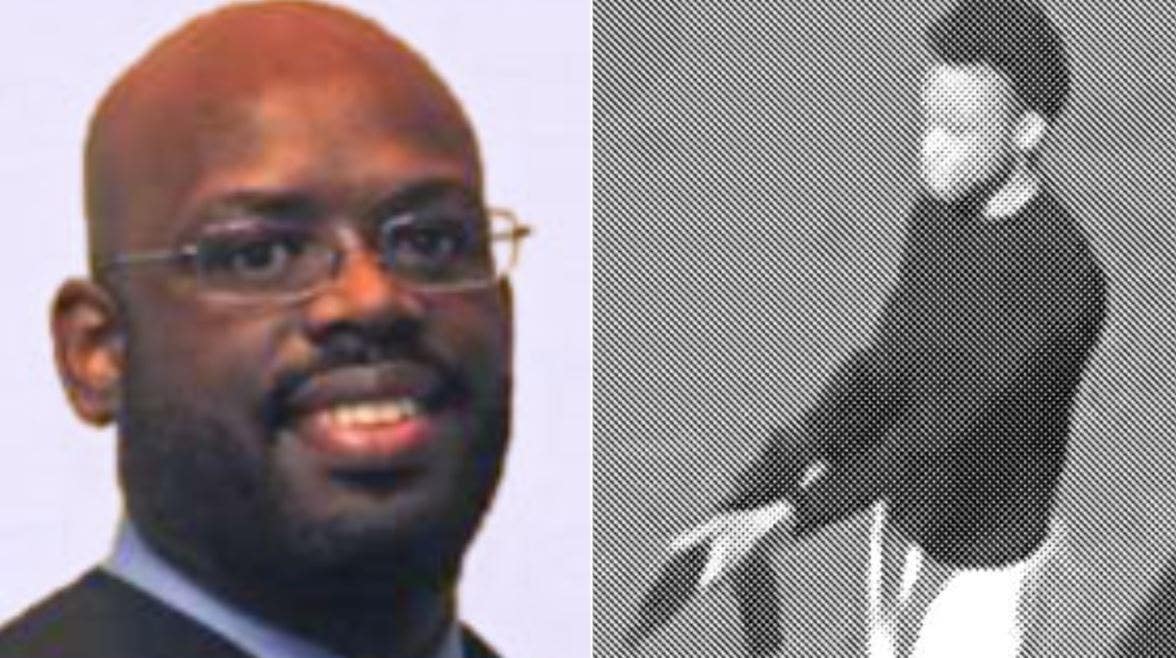North Dakota
Historically Speaking:\u00a0North Dakota’s workhorses come to Exeter

The Great Depression started early in some parts of the country. New Hampshire had been suffering from an economic downturn since just after World War I. Things were far worse in North Dakota.
Historian Elwyn Robinson has written, “The 1920s in North Dakota were a time of readjustment. The stimulus of pioneering had vanished. Settlement of the semiarid state by people from humid regions had left a heritage of maladjustment, of institutions unsuited to the nature of the country.”
Unlike New Hampshire, which is small, North Dakota has vast territory. The rush for homesteading in the late 1800s had slowed and years of drought found many leaving the state. “Because they had anticipated a denser population and a greater production of wealth than the state has yet attained, the pioneers created too many farms too many towns, too many schools, churches, and colleges, too many counties and too much government, too much railroad mileage, too many banks and too much debt.” Robinson called this the “Too-Much Mistake.”
To improve the economic strain in the state, many North Dakota farmers joined cooperatives and the North Dakota Farm Bureau organized as part of the larger American Farm Bureau. Concerns with grain prices took precedence, but the question of raising ready cash was also at the forefront. Was there some unused resource that might pull in some quick income? It seems there were: horses.
It turns out, North Dakotans owned more autos than most states. “In 1913, North Dakotans owned only 12,075 automobiles, but by 1920 they owned 92,000, and 57% of the state’s farmers had them.” Robinson cites that by 1930, the percentage of farmers owning cars or tractors had gone up to 87% – “one for every 3.7 persons.” The national average was one for every 5.3 persons. So, if the state no longer needed horses for transportation or labor, they could be sold in other parts of the country.
Western horses had an excellent reputation back east. These weren’t wild mustangs, they were solid, well-broken-in, reliable workhorses. Local farm bureaus, primarily in New Hampshire and Vermont, began making arrangements to bring some of these well-mannered horses to auction. New England farmers were still happy to use horse labor. The region has abundant hay resources, unlike the arid plains, and is compacted into a smaller area.
The auctions began in 1922. Two years later, one of the sales came to Exeter.
“Thirty heads of horses direct from Dakota farmers will be sold at auction under a positive guarantee. The horses are accustomed to all classes of farm work and are mostly Percheron and Belgian breeding from 5 to 9 years old and weigh from 1200 to 1700 pounds,” ran an advertisement in early April of 1924 in the Exeter News-Letter. “Practically every horse sold by us in the past two years has given splendid satisfaction. Ask your County Farm Bureau about our sales.”
Finding the advertising was a tremendous help to the Exeter Historical Society. The organization received a collection of nearly two thousand slides in 2022 associated with the Tufts family of Exeter. The patriarch of the family, James Arthur Tufts, Sr., was a long-time teacher at Phillips Exeter Academy. His son, James Arthur Tufts, Jr., went into agriculture and ran the Granite State Nursery on High Street. Among the images were three that looked down on a gathering of people surrounding various horses. Taken from the second story of the farm’s house, the photos were too fuzzy to be featured in the annual Historical Society calendar but clear enough to depict some type of local event. The dates matched those of a cryptic entry in James’ sister, Betty’s diary for the year 1924: “Saturday, Apr. 12, 1924. Gave 5 lessons. Over to Jim’s on a 2 o’clock trolley with Father & Aunt Sue to see the horse auction. 30 horses from N. Dakota. Mother went to sta. to see them come.” Betty was a frequent horseback rider, but these horses would not have suited her. Percheron and Belgians are enormous working breeds – the kind you might see at a horse-pulling competition at the fair.
The auctioneer arrived from North Dakota with the horses. His name was Frank Hyland, who was not only the auctioneer (indeed he was so skillful at the art that he often taught it to aspiring students) but was also serving as sitting Lieutenant Governor for the state of North Dakota. The Exeter News-Letter described him as “efficient” after “he sold the entire 28 head in quick time at prices ranging from $100 to $300.”
The sale fulfilled two purposes: high-quality western horses came to New England while bringing in much-needed cash to the strapped counties of North Dakota. Buyers were assured that “a committee appointed by the Rockingham County Farm Bureau will inspect and hitch all the horses prior to the sale and will report on each horse at the sale.” How well the horses served after the sale is not recorded, however at least one registered its discontent: “An unfortunate incident was the injury to Mr. Lloyd Snell, of Brentwood, who was kicked by a horse he had bought, several ribs being fractured. He was taken to Exeter Hospital.”
Barbara Rimkunas is the curator of the Exeter Historical Society. Support the Exeter Historical Society by becoming a member! Join online at: www.exeterhistory.org.

North Dakota
Initial test finds 'forever chemical' in Mount Rushmore drinking water at level exceeding new limit • South Dakota Searchlight

A sample of Mount Rushmore National Memorial’s drinking water had levels of a “forever chemical” exceeding new limits established by the federal government.
Perfluorooctane sulfonic acid, or PFOS, is a member of the synthetic chemical group known collectively as perfluorinated alkylated substances, or PFAS. The chemicals have been used in industry and consumer products since the 1940s and don’t break down easily in the environment or in the human body. Research indicates PFAS exposure may be linked to negative developmental and reproductive effects, and an increased risk of some cancers.
A 2023 test of Mount Rushmore’s drinking water showed a PFOS concentration of 9.8 parts per trillion, more than two times higher than the Environmental Protection Agency’s new limit of 4 parts per trillion. The EPA finalized limits for several types of PFAS last month.
The result doesn’t necessarily mean Mount Rushmore is out of compliance with the EPA’s new rule, which will be implemented in phases. Current testing is preliminary. Tests won’t count toward the new limits until 2027, and the EPA will use annual running averages to determine compliance. The EPA won’t begin issuing violations until 2029.
Proposed EPA ‘forever chemicals’ regulation could cost SD millions for testing, cleanup
The current sampling is part of a multi-year, nationwide testing effort by the EPA. The South Dakota Association of Rural Water Systems is conducting a majority of the testing in the state.
In publicly available results published so far, Mount Rushmore is the only site in South Dakota to test above the new EPA limits for forever chemicals. Additional Mount Rushmore sampling results will be published in the coming weeks and months. Elsewhere in South Dakota, some of the chemicals have been detected at levels below the new EPA limits.
PFAS from firefighting foam was previously known to have contaminated groundwater at military installations in or near locations including Rapid City and Sioux Falls, leading to mitigation efforts in those areas.
In an emailed statement, Mount Rushmore National Memorial spokesman Earl Perez-Foust said the National Park Service is monitoring the results and considering any mitigation that may be necessary.
“This could include treatment or considering a new water source,” Perez-Foust said. “Public health and safety is always our top priority.”
Reverse osmosis, granular activated carbon, nanofiltration and other methods have been identified as methods of removing PFAS from drinking water, according to the EPA.
The exact source of the contamination at Mount Rushmore is unknown, said Galen Hoogestraat, a hydrologist for the U.S. Geological Survey’s Dakota Water Science Center.
“In general, PFAS sources can come from anywhere humans are interacting with the environment: food wrappers, water-resistant clothing, common products and waste,” Hoogestraat said.
80% of tested surface water in South Dakota fails to meet state standards
For over a decade, Hoogestraat has studied perchlorate contamination in Mount Rushmore’s groundwater and local streams from former fireworks displays at the memorial. He said the amount of perchlorate in the water has “dropped substantially” in the last decade.
Hoogestraat said the memorial provides water to over 2 million visitors every year from a “very small postage stamp of an area in the Black Hills,” because the memorial is limited to using water from within the park boundaries.
That source is a fractured rock system that collects rain and groundwater, which makes it susceptible to contamination.
“There’s very little soil on top of the rocks, so there’s very little filtration of anything that comes from the surface — good or bad,” Hoogestraat said.
That can create volatile test results, since concentrations of contaminants can vary based on the seasons and weather conditions.
“There needs to be more sampling done to assess the variability around this,” Hoogestraat said, “and wrap our arms around the trends of this: Is this a long-term, persistent thing, or will this be variable over time?”
GET THE MORNING HEADLINES DELIVERED TO YOUR INBOX
North Dakota
Canadian wildfire smoke impacts FM Metro and most of North Dakota

(WDAY Radio) — Large wildfires in Canada’s British Columbia are causing poor air quality conditions across North Dakota.
Due to the wildfires, air quality is considered unhealthy across the state. This includes large population centers like the FM Metro, Bismarck, Minot, Grand Forks, and more. Experts recommend limiting time outdoors if possible you have respiratory health conditions impacted by poor air quality.
You can find more information by clicking here.
North Dakota
Both Coyote teams claim second at Summit Track & Field meet

ST. PAUL, MN (Dakota News Now) – The top of the Summit League Track and Field Championship standings were a mirror image on both the men’s and women’s side with North Dakota State, South Dakota and South Dakota State going first through third place in 2024.
MEN’S TEAM STANDINGS
1. NDSU (190)
2. USD (175)
3. SDSU (158)
4. St. Thomas (112)
5. UMKC (66)
6. UND (60)
7. Oral Roberts (49)
WOMEN’S TEAM STANDINGS
1. NDSU (238)
2. USD (197)
3. SDSU (131.5)
4. UND (109.5)
5. St. Thomas (71)
6. UMKC (38)
7. Omaha (23)
8. Oral Roberts (11)
Click on the video viewer for highlights from the final day of competition! Recaps from USD and SDSU courtesy their media relations departments are below.
CORRECTION-In the highlights we state that Erin Kinney won the 200 meter dash. It was in fact Sara Reifenrath who edges her 23.30 seconds to 23.78 seconds
USD RECAP
South Dakota broke three more Summit League Championship meet records Saturday at O’Shaughnessy Stadium. Redshirt-junior Sara Reifenrath captured the women’s Track Championship MVP and fifth-year senior Meredith Clark took home the women’s Field Championship MVP from the meet.
Reifenrath, the Track Championship MVP, returns to Vermillion with four gold medals from the weekend and 25 points scored. She clocked a Summit League Championship meet record and a South Dakota program record of 52.81 seconds to take gold in the 400 meters, holding off indoor champion Nell Graham of NDSU down the home stretch. Reifenrath also took gold in the open 200 meters in 23.30 seconds, just one-tenth of a second off her own meet record from 2022. She’s captured three career titles in both the 200 meters and 400 meters. She also anchored the Coyotes’ victorious 4×100-meter and 4×400-meter relays.
Clark garnered the Field Championship MVP award for the second-straight year. She totaled 22 points with a pair of gold medals in the throwing events. After winning the shot put title yesterday, Clark returned to win the discus throw today. Her best mark of 161-2 (49.13m) came on her final throw of the competition. A Coyote has won the discus two years in a row.
In her final conference meet, senior Jacy Pulse took a victory lap in the 400-meter hurdles by breaking her own Summit meet record from yesterday’s preliminary with a clocking of 57.70 seconds. She’s won the event for three-straight years. Pulse also ran on the Coyotes’ championship 4×100-meter and 4×400-meter relays.
The women’s 4×100-meter relay of senior Erin Kinney, Pulse, junior Averi Schmeichel and Reifenrath opened up the running events Saturday by setting a new Summit League Championship meet record of 44.54 seconds. USD held the previous record of 44.99 seconds from 2022. The Coyotes have won three-straight league titles in the 4×100 relay and four overall.
Kinney successfully defended her title in the open 100 meters with a time of 11.38 seconds. She was just .04 shy of yesterday’s Summit League Championships meet record set in the preliminaries. Kinney was also runner-up to Reifenrath in the 200 meters, clocking 23.78 seconds.
The quartet of Schmeichel, Pulse, fifth-year senior Madison Jochum, and Reifenrath captured South Dakota’s fourth-straight championship title in the women’s 4×400-meter relay with a clocking of 3:40.68. The time was just off last year’s championship meet record of 3:40.25.
Sophomore Mikael Grace captured his first Summit League Championship title, taking the 110-meter hurdles in a personal record time of 13.90 seconds. His time ranks fifth in USD program history. He also finished seventh in the 400-meter hurdles with a clocking of 55.61 seconds.
Freshman Jaden Guthmiller, who entered the Summit meet with the 14th-best seed time in the men’s 100 meters, heads home a Summit League champion in the event. He took the tape in a personal best 10.31 seconds. The time ranks third in USD program history. Guthmiller also clocked a personal record 21.45 seconds in the 200 meters, finishing fourth in the event.
Fifth-year senior Marshall Faurot successfully defended his Summit League title in the men’s pole vault and the Coyotes swept the top-four spots. USD swept the podium in both pole vault competitions. Faurot was the lone athlete to clear 17-3 ¾ (5.28m) to win. Redshirt-junior Tre Young finished runner-up with a clearance of 17-0 (5.18m) and junior Spencer Buley rounded out the podium with a clearance at the same height. Buley’s make of 17-0 (5.18m) was a season best. Senior Eerik Haamer took fourth in the field, also clearing 17-0 (5.18m).
South Dakota finished with 13 conference champions with Clark (shot put), junior Joe Lynch (high jump) and senior Gen Hirata (pole vault) joining Saturday’s victors.
The Coyotes finished runner-up in both team races to North Dakota State. South Dakota’s men finished with 175 points to North Dakota State’s 190 points. The Coyote women finished with 197 points to the Bison’s 238 points.
Schmeichel, in addition to her gold medals in the 4×100-meter and 4×400-meter relays, made the podium in both hurdle races. She finished runner-up in the 100-meter hurdles in a personal best time of 13.30 seconds. The time is a new South Dakota program record in the event. She also placed third in the 400-meter hurdles with a personal best time of 59.10 seconds, breaking the minute barrier for the first time this weekend. Her time ranks third in USD program history.
Redshirt-sophomore Mason Sindelar had a stellar performance in the men’s 1,500-meter run, finishing runner-up in 3:45.94. The Coyotes were not seeded to score in the event with Sindelar entering the meet with the 11th-best time this spring. He finished strong down the final 200 meters with a five-second personal best. The top three athletes were all under the previous conference meet record.
On the women’s side for the 1,500 meters, fifth-year senior Ella Byers finished runner-up in a season-best time of 4:28.29. She also took seventh in the 800-meter run.
Junior Thomas Nikkel took the silver in the men’s 400 meters with a personal best time of 47.22 seconds. He also finished sixth in the 200 meters. Sophomore Mark Daley was seventh in the 200 meters and eighth in the 400 meters.
The men’s 4×100-meter relay of Guthmiller, Nikkel, fifth-year senior Ardell Inlay and Daley finished runner-up in 40.10 seconds.
Freshman Carsen Staehr added a podium finish in the men’s triple jump, taking second in 48-10 ¼ (14.89m). Junior Jayden Green was sixth and sophomore Bennett Schwenn was seventh.
Junior Anna Robinson took fourth in the 400 meters with a time of 54.73 seconds and fifth in the 200 meters in a personal best 24.26 seconds.
Fifth-year senior Madison Jochum clocked 2:11.92 to finish fourth in the women’s 800 meters.
Junior Lauren Meyer placed fifth in the women’s triple jump with a leap of 39-4 ½ (12.00m).
Junior Wyatt Pruce took sixth and sophomore Quincy Warren was seventh in the men’s discus competition. Sophomore Kinsley Ragland was seventh in the women’s discus with a personal best throw of 137-3 (41.85m).
Select Coyote athletes will advance on to the NCAA West Preliminary meet held May 22-25 in Fayetteville, Arkansas. Qualifiers will be announced next week.
Summit League Championships Men’s Point Scorers
1. Mikael Grace, 110m hurdles, 13.90 seconds
1. Jaden Guthmiller, 100m, 10.31 seconds
1. Marshall Faurot, pole vault, 17-3 ¾ (5.28m)
2. Tre Young, pole vault, 17-0 (5.18m)
3. Spencer Buley, pole vault, 17-0 (5.18m)
4. Eerik Haamer, pole vault, 17-0 (5.18m)
1. Joe Lynch, high jump, 6-9 ½ (2.07m)
2. Ethan Heitman, high jump, 6-9 ½ (2.07m)
2. Mason Sindelar, 1,500m, 3:45.94
2. Thomas Nikkel, 400m, 47.22 seconds
8. Mark Daley, 400m, 49.68 seconds
2. Tristan Gray, shot put, 54-9 ¼ (16.69m)
2. Quincy Warren, hammer throw, 183-10 (56.05m)
3. Tristan Gray, hammer throw, 176-1 (53.69m)
4. Wyatt Pruce, hammer throw, 164-7 (50.18m)
2. Bennett Schwenn, long jump, 24-1 (7.34m)
3. Carsen Staehr, long jump, 23-7 ½ (7.20m)
6. Jayden Green, long jump, 23-2 ¾ (7.08m)
2. Carsen Staehr, triple jump, 48-10 ¼ (14.89m)
6. Jayden Green, triple jump, 47-8 ½ (14.54m)
7. Bennett Schwenn, triple jump, 47-7 ¾ (14.52m)
2. Jaden Guthmiller, Thomas Nikkel, Ardell Inlay, Mark Daley, 4x100m relay, 40.10 seconds
4. Jaden Guthmiller, 200m, 21.45 seconds
6. Thomas Nikkel, 200m, 21.96 seconds
7. Mark Daley, 200m, 26.49 seconds
5. Derek Eidsness, decathlon, 6,629 points
6. Townsend Barton, decathlon, 6,618 points
7. Noel Spence, decathlon, 6,441 points
6. Wyatt Pruce, discus, 157-0 (47.86m)
7. Quincy Warren, discus, 155-5 (47.39m)
7. Mikael Grace, 400 hurdles, 55.61 seconds
Summit League Championships Women’s Point Scorers
1. Sara Reifenrath, 400m, 52.81 seconds
4. Anna Robinson, 400m, 54.73 seconds
1. Jacy Pulse, 400m hurdles, 57.70 seconds
3. Averi Schmeichel, 400m hurdles, 59.10 seconds
1. Erin Kinney, 100m, 11.38 seconds
1. Sara Reifenrath, 200m, 23.30 seconds
2. Erin Kinney, 200m, 23.78 seconds
5. Anna Robinson, 200m, 24.26 seconds
1. Meredith Clark, shot put, 52-0 ½ (15.86m)
1. Meredith Clark, discus, 161-2 (49.13m)
7. Kinsley Ragland, discus, 137-3 (41.85m)
1. Gen Hirata, pole vault, 14-1 ¼ (4.30m)
2. Jaidyn Garrett, pole vault, 13-4 ½ (4.08m)
3. Eliza Aitken, pole vault, 12-10 ¾ (3.93m)
7. Kailee Swart, pole vault, 12-10 ¾ (3.93m)
1. Erin Kinney, Jacy Pulse, Averi Schmeichel, Sara Reifenrath, 4x100m relay, 44.54 seconds
1. Averi Schmeichel, Jacy Pulse, Madison Jochum, Sara Reifenrath, 4x400m relay, 3:40.68
2. Averi Schmeichel, 100m hurdles, 13.30 seconds
2. Ella Byers, 1,500m, 4:28.29
2. Kenzie Campbell, hammer throw, 185-2 (56.45m)
6. Delaney Smith, hammer throw, 176-4 (53.76m)
7. Meredith Clark, hammer throw, 175-10 (53.59m)
8. Riley Griffith, hammer throw, 165-7 (50.47m)
2. Danii Anglin, high jump, 5-7 ¾ (1.72m)
3. Maddie Olson, high jump, 5-7 ¾ (1.72m)
5. Matayah YellowMule, high jump, 5-5 ¾ (1.67m)
4. Madison Jochum, 800m, 2:11.92
7. Ella Byers, 800m, 2:17.72
4. Sammy Neil, long jump, 19-3 ¼ (5.87m)
8. Matayah YellowMule, long jump, 18-7 ¼ (5.67m)
5. Lauren Meyer, triple jump, 39-4 ½ (12.00m)
8. Abbie Schmidt, 3,000m steeplechase, 11:08.43
SDSU RECAP
South Dakota State track and field finished third in both the men’s and women’s team standings after medaling in 14 different events on Saturday at the 2024 Summit League Championships.
Three Jackrabbits won the conference titles, starting with James Pierce, who won the 400-meter dash in a personal best of 47.12, now second all-time. Thailan Hallman also took fifth in 47.65 for a new PR and the sixth-fastest time in school history.
Claire Beckman was champion of the 800-meter finals, clocking a PR of 2:10.09 (now eighth all-time), and Grace Waage took bronze in 2:11.22.
Leah Hisken defended her 5k title, winning the gold in a time of 17:25.98. Jessica Lutmer (17:43.75) came seventh and Ashlyn Hillyard (17:52.50) was eighth.
Additional Jackrabbits earning a trip to the podium include Milee Young, who was runner-up in the women’s discus at the championship meet with a throw of 153-05.00.
Brielle Dixon broke her own school record in 13.37 seconds to take third place as Savannah Risseeuw finished fifth with a PR of 13.61, now third in school history.
The women’s 4×100-meter relay team of Dixon, Risseeuw, Maggie Madsen and Jaiden Boomsma ran into second place with a time of 45.90, taking the silver medal with the fourth-fastest time in school history.
Jessica Boekelheide, Emily Rystrom, Madsen and Erika Kuntz teamed up for the bronze medal in in the 4×400-meter relay with a time of 3:44.52, now fourth on the SDSU All-Time List.
Jake Werner took home two medals on the day, as he ran a 10.46 in the 100-meter dash finals for a third place finish and a 21.25 for second place in the 200-meter dash.
Carson Noecker tallied his second silver medal of the championship meet after running a 14:15.41 in the 5k. Josh Becker (14:40.89) was fifth and Will Lohr (14:43.89) came eighth.
Tristen Hanna leaped his way onto the podium for the triple jump with a mark of 48-08.00.
Ethan Fischer was runner-up in the discus, taking silver with a mark of 172-06.00, while Caiden Fredrick was third with a 169-08.00. Ryan Hackbart (153-07.00, PR) also scored for SDSU, taking eighth place.
SDSU then clocked the sixth-fastest men’s 4×100-meter relay time (40.58) in school history enroute to a bronze medal courtesy of Evan Henderson, Werner, Carter Toews and Drew Olson.
The 4×400-meter relay team of Sam Castle, Hallman, Kudra Nzibariza and Pierce clocked the eighth-fastest time in school history (3:12.99) to take silver.
In other results, Carter Johnson finished sixth in the 110-meter hurdle finals with a new PR of 14.47, now ninth on the SDSU All-Time List, as Jeremiah Donahoe ran a 55.54 for sixth in the 400-meter hurdle finals.
Daniel Burkhalter and Brandon Kampsen finished back-to-back in the 800-meter finals, clocking a 1:55.30 for seventh and 1:56.58 for eighth place, respectively. Burkhalter also scored for the Jackrabbits in the 1500-meter run with a fourth-place finish in 3:46.89
Matt Katz and Ryan Karajanis finished back-to-back in the men’s pole vault, taking seventh (15-06.25) and eighth (15-00.25), respectively.
Boomsma ran a time of 11.93 for a fifth place finish in the 100-meter dash finals as Rich-Ann Archer took seventh in 12.08.
In the finals of the 400-meter dash, Kuntz ran a 57.05 for seventh place as Boekelheide took eighth with a PR of 57.46.
Risseeuw crossed the finish line in a time of 1:04.24 for eighth place in the 400-meter hurdle finals while Nicole Greyer clocked a 4:33.77 in the 1500-meter run for a fifth place finish.
The SDSU men finish third in the team standings with 158 points as North Dakota State took first with 190 points and South Dakota was second with 175 points.
On the women’s side, SDSU came third with 131.5 points while North Dakota State won with 238 points and South Dakota came second with 197 points.
UP NEXT: Should SDSU have any qualifiers, the NCAA West Regional Prelims will take place May 22-25 in Fayetteville, Arkansas.
Copyright 2024 Dakota News Now. All rights reserved.
-

 Education1 week ago
Education1 week agoVideo: President Biden Addresses Campus Protests
-

 Movie Reviews1 week ago
Movie Reviews1 week agoSabari Movie Review: Varalaxmi Proves She Can Do Female Centric Roles
-

 World1 week ago
World1 week agoEuropean elections: What do voters want? What have candidates pledged?
-

 News1 week ago
News1 week agoWhistleblower Joshua Dean, who raised concerns about Boeing jets, dies at 45
-

 World1 week ago
World1 week agoBrussels, my love? Champage cracked open to celebrate the Big Bang
-

 Politics1 week ago
Politics1 week agoAustralian lawmakers send letter urging Biden to drop case against Julian Assange on World Press Freedom Day
-
News1 week ago
A group of Republicans has united to defend the legitimacy of US elections and those who run them
-

 Politics7 days ago
Politics7 days agoHouse Dems seeking re-election seemingly reverse course, call on Biden to 'bring order to the southern border'



















